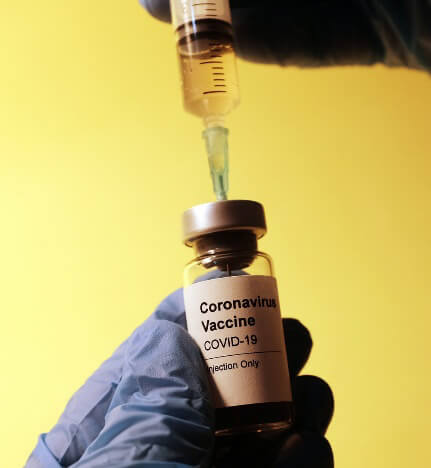January 2021: A Fresh Start
In this edition:
- PFAS, Forever or Never?
- Science and Communication Strategy Workshop
- New EPA Announcements on PFAS a Mixed Bag
- A Big Mistake in Michigan -- Decades Later
- Could PFAS reduce the effectiveness of your COVID-19 vaccination?
- CALENDAR
I hope you are as pleased as I am to leave 2020 behind. With vaccines on the horizon, we are looking forward to a healthier year ahead.
We are also delighted to launch our new website at www.greensciencepolicy.org. The two-year long revamp was a huge undertaking for us and we trust you’ll find our updated site useful and easy to navigate. Please do check out the new content and fresh look and give us your feedback and ideas for further improvements.
Other good news on our Institute’s communications: We learned that four of the top 20 most-read articles in Environmental Science & Technology Letters were co-authored by scientists at our Institute. This is a rewarding testimonial to the science and communication strategy we’ve developed over the last decade.
Now we are prioritizing sharing that communications strategy with other scientists. Our objective is to help scientists studying chemicals of concern communicate better and increase the impact of their research. To get started, we are offering a pilot Science and Communication Strategy Workshop on March 10 and 17. Participants will come away with a vision for maximizing the reach of their research, an “elevator pitch” to briefly describe it, and a detailed communications plan. Might you or a colleague who studies chemicals be interested in participating? More about the workshop and how to apply is below.
With good wishes for a healthy and happy 2021,
Arlene and the Green Science Policy team
PFAS, Forever or Never?
In more good news, following a powerful national campaign by Safer Chemicals, Healthy Families and other NGOs, McDonald’s announced it will remove all PFAS from their packaging worldwide by 2025. We are happy to have helped initiate this movement away from PFAS in 2017 with our joint paper on PFAS in fast-food packaging and a pivotal meeting of stakeholders along the supply chain.
According to Allen King, a food packaging executive who attended our 2017 meeting, “It was an ‘aha’ moment that led us to commit to finding ways to cease using PFAS and find alternatives.” We hope more restaurants and retailers will follow suit.
In an overlap of my mountain and molecules worlds, PFAS were detected in the snow in climbing camps leading to the summit of Mount Everest. This contamination could pose a risk for climbers and local residents who drink the meltwater. The PFAS likely comes from clothing, ropes, and other climbing gear. We plan to share this research with the outdoor industry to encourage them to stop using PFAS as quickly as possible. In the meantime, consider purchasing gear listed on our PFAS-free product page.
Closer to home, birdwatching is another outdoor activity to enjoy while wearing PFAS-free gear. I just appreciated listening to a heart-warming new Podship: Earth interview with Meredith Williams and Jared Blumenfeld about birding. Meredith, who leads the California Department of Toxic Substances Control, shares her linked enthusiasm for birdwatching and reducing chemical harm, as well as her fascinating personal path.
Science and Communication Strategy Workshop
Over the last decade the Green Science Policy Institute has contributed to changing government policy and business purchasing to protect our health from toxic chemicals. These successes have been based on our unique strategy for translating scientific research into positive change.
Are you a scientist interested in learning about our strategy and considering applying it to increasing the impact of your work? If so, you are invited to apply to our Science and Communication Strategy Workshop.
During this two-part online workshop on March 10 and 17, scientists and communications experts will share inspirational stories and practical advice to boost the impact of your research. Through interactive exercises and small and large group discussions, you will develop the tools to more effectively use your science to protect public health.
When:
Session 1 on March 10, 2021 from 10:00am to 12:30pm PST
Session 2 on March 17, 2021 from 10:00am to 12:30pm PST
What: The first session will cover scientific strategy such as selecting a research topic to support policy in the public interest. The second session will cover communications strategy including impactful writing, choosing an optimal release date, composing a press release in accessible language with a “hook” to attract attention, and speaking with the press.
We ask participants to commit to participating in the full 2.5-hour program each day as well as completing prework and homework.
Speakers: Experts from the Science Communication Network, the University of Toronto, the Silent Spring Institute, the University of San Francisco, and Green Science Policy Institute.
To learn more and apply, please click here.
The deadline to apply is Monday, February 15, 2021 at 5:00pm PST.
You will be notified by February 19 if your place is confirmed.
New EPA Announcements on PFAS a Mixed Bag
By Tom Bruton
EPA announced last week that it is moving forward to develop enforceable drinking water limits for two prominent PFAS chemicals, PFOA and PFOS. This is welcome news, as along with enforceable limits will come a requirement that water systems test for these compounds. Testing is critical because identifying contaminants is the first step towards providing clean drinking water.
It is important that the cost of removing these chemicals from drinking water does not fall solely on water systems or rate payers, many of whom are already in dire financial straits. Instead, the costs of PFAS cleanup should be borne by polluters—those who released PFAS into the environment in the first place.
One way for EPA to increase polluter accountability for PFAS cleanup would be to designate PFAS as hazardous under CERCLA and/or RCRA, the federal laws that regulate hazardous wastes. EPA committed to a hazardous designation for PFOA and PFOS at its 2018 PFAS Summit, but in another announcement last week, the agency seems to be signaling that this decision is now up in the air. Whether this is backsliding or a thoughtful reconsideration of the best solution remains to be seen. We’ll be keeping an eye on it.
A Big Mistake in Michigan -- Decades Later
By Anna Soehl
A recent study found that a majority of Michigan residents tested had elevated levels of the flame retardants polybrominated biphenyls (PBBs) compared to the rest of the U.S. population. PBBs are very similar in structure and properties to PBDE flame retardants, which were used in furniture and baby product foam for decades and can still be found in older products in our homes.
The cause is a big mistake made by the Velsicol Chemical Company in 1973. By accident, a bag containing PBB flame retardants was mislabeled as an animal feed supplement and the toxic chemicals were added to livestock feed. Animals began dying and ultimately tens of millions of cows and other farm animals had to be destroyed. Meanwhile, millions of Michigan residents who ate contaminated beef, chickens, pork, milk, and eggs were also ingesting the PBBs.
This toxic tragedy was the subject of the award-winning movie, Bitter Harvest, and Joyce Egginton's classic chemical suspense story, The Poisoning of Michigan.
Long-term health effects continue to impact not only those who were directly exposed, but also their children and grandchildren. Problems include increased risk of lymphomas and cancers of the digestive tract, higher rates of breast cancer and miscarriages in women, and an increase in adverse genital or urinary conditions in sons of women with high exposure. Results from a more recent study indicate impacts on sperm DNA that can contribute to reproductive, developmental, and endocrine harms in future generations.
These intergenerational adverse health effects are of concern today. PBBs are very similar in structure and properties to PBDEs that were used as a flame retardant in furniture and baby product foam for decades and are still found in older products in our homes--as well as in the bodies of most Americans. And the PBDEs were used until 2014 primarily to meet an ineffective furniture flammability standard! Once again we learn flame retardants should only be used when needed-- and with great caution.
Information on participating in ongoing PBB research, community meetings, etc. is available from the Michigan PBB Registry Project at Emory University. To learn more about other flame retardants and how to reduce your exposure, visit our Six Classes website.
Could PFAS reduce the effectiveness of your COVID-19 vaccination?
By Hannah Ray
PFAS chemicals such as PFOA and PFOS are well known to be associated with a wide variety of health problems. Could PFAS exposure also reduce the effectiveness of COVID-19 vaccinations? To answer this important question, the U.S. Centers for Disease Control and Prevention is conducting a study of healthcare workers and first responders looking for correlations between PFAS levels and antibody response to the coronavirus.
Certain PFAS are known to impact the human immune system. This includes associations with decreased resistance to infections and cancer and increased autoimmune disease incidence. So it’s not surprising that past studies found that PFAS exposure could reduce the effectiveness of vaccines for diphtheria and tetanus, rubella and mumps, and influenza. However, the mechanisms of immune system suppression are not well understood, nor is it possible to predict how different types of PFAS in the body might interact with specific vaccines.
A recent study by Philippe Grandjean at Harvard found correlation between elevated blood levels of a short-chain PFAS, called PFBA, to more severe courses of COVID-19 infections. Given what is already known about PFAS and the immune system, as the new COVID-19 vaccines begin to be distributed worldwide, it makes good sense to monitor vaccine responses in populations with high PFAS exposure. Their potential to reduce the efficacy of vaccinations is yet another reason to limit the unnecessary use of PFAS chemicals.
CALENDAR
February 24, 2021: Homebodies and Waterbodies: How to reduce harmful chemicals potentially lurking in your home
When: 12 P.M. – 1 P.M. PST
Arlene Blum will give a talk for the Columbia Riverkeeper about the harmful chemicals found in household items, how they end up in the river, their impacts, and what can be done to reduce harm.
February 25, 2021: Wilderness Medical Society Winter Virtual Conference
When: 8:45 A.M. - 9:45 A.M. PST
Arlene Blum will give a keynote entitled "Breaking Trail: Mountains and Molecules" during the Wilderness Medical Society's 2021 Winter Conference.
March 10 & 17, 2021: Science and Communication Strategy Workshop
When: 10:00 A.M. - 12:30 A.M. PST
Scientists and communications experts will share inspirational stories and practical advice to increase the impact of participants' research during our Institute's pilot Science and Communication Strategy Workshop. During interactive exercises and small and large group discussions, participants will develop tools to use their research to protect public health.<
The deadline to apply is Monday, February 15, 2021 at 5:00 P.M. PST. Applicants will be notified by February 19 whether or not their participation is confirmed.
April 22, 2021: Living Future 21
When: 1:30 P.M. - 2:30 P.M. PST
Arlene Blum will join a panel at the ILFI Living Furniture 21 meeting entitled "Transforming the Material Supply Chain: From the Lab Bench to the Job Site."
2:45 P.M. - 3:45 P.M. PST
Tom Bruton and Seth Rojello Fernández will give a talk at the ILFI Living Future 21 meeting. The title of their talk is: "Tracking Down Forever Chemicals in Building Products and Seeking Healthier Alternatives."
Receive Updates By Email
Subscribe to our monthly newsletter and get these updates delivered right to your inbox!





